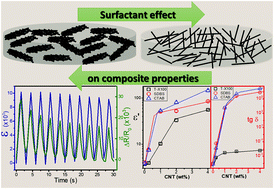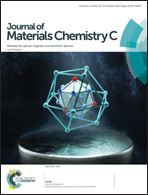On the use of surfactants for improving nanofiller dispersion and piezoresistive response in stretchable polymer composites†
Abstract
Conducting polymer composites are increasingly investigated for the development of piezoresistive materials for sensor applications due to their outstanding electromechanical properties. In this work, the effect of different surfactants on the piezoresistive response of triblock copolymer styrene–ethylene/butylene–styrene (SEBS)/multi-walled carbon nanotubes (MWCNT) composites was studied. Surfactants act as dispersing agents for MWCNT decreasing the size of agglomerates. The use of different surfactants such as Triton-X100 (TX-100), cetyltrimethylammonium bromide (CTAB) and sodium dodecylbenzenesulfonate (SDBS) affects the percolation threshold as well as the mechanical and piezoresistive properties of the composites. TX-100 decreases the mechanical response and electrical conductivity of the polymer composites, leading also to low piezoresistive response. CTAB and SDBS decrease the size of the agglomerates while maintaining their electrical conductivity up to 4 wt% MWCNT. Moreover, these composites present improved piezoresistive response with GF values up to 3 and deformations up to 10%, similar to the behaviour of commercial sensors, with improved filler dispersion within the SEBS polymer, promoting their use in a novel range of printable methods.



 Please wait while we load your content...
Please wait while we load your content...